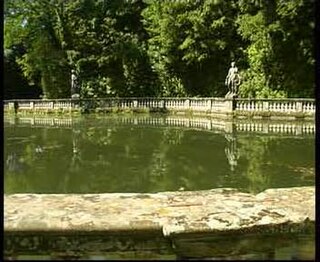
Lucca is a city and comune in Tuscany, Central Italy, on the Serchio, in a fertile plain near the Ligurian Sea. It is the capital of the Province of Lucca. It is famous for its intact Renaissance-era city walls.

The Province of Lucca is a province in the Tuscany region of Italy. Its capital is the city of Lucca.

The Palazzo Barberini is a 17th-century palace in Rome, facing the Piazza Barberini in Rione Trevi. Today it houses the Galleria Nazionale d'Arte Antica, the main national collection of older paintings in Rome.

The Cortile del Belvedere was a major architectural work of the High Renaissance at the Vatican Palace in Rome. Designed by Donato Bramante from 1505 onward, its concept and details reverberated in courtyard design, formalized piazzas and garden plans throughout Western Europe for centuries. Conceived as a single enclosed space, the long Belvedere court connected the Vatican Palace with the Villa Belvedere in a series of terraces connected by stairs, and was contained on its sides by narrow wings.

Lucca Comics & Games is an annual comic book and gaming convention in Lucca, Italy, traditionally held at the end of October, in conjunction with All Saints' Day. It is the largest comics festival in Europe, and the second biggest in the world after the Comiket.

The Orto Botanico Comunale di Lucca is a botanical garden located at Via del Giardino Botanico, 14, Lucca, Italy, and operated by the city. It is open daily during the warmer months, and weekday mornings off-season. An admission fee is charged.

The Villa Medicea di Cafaggiolo is a villa situated near the Tuscan town of Barberino di Mugello in the valley of the River Sieve, some 25 kilometres north of Florence, central Italy. It was one of the oldest and most favoured of the Medici family estates, having been in the possession of the family since the 14th century, when it was owned by Averardo de' Medici. Averardo's son, Giovanni di Bicci de' Medici, is considered to be the founder of the Medici dynasty.

The Villa Marlia or Villa Reale di Marlia — a late-renaissance palazzo or villa, and its estate's property that includes renowned gardens and adjacent villas and follies within the compound. It is located in Capannori, in the Province of Lucca, west of Florence, in the northern Tuscany region of Italy.

The Medici villas are a series of rural building complexes in Tuscany which were owned by members of the Medici family between the 15th century and the 17th century. The villas served several functions: they were the country palaces of the Medici, scattered over the territory that they ruled, demonstrating their power and wealth. They were also recreational resorts for the leisure and pleasure of their owners; and, more prosaically, they were the centre of agricultural activities on the surrounding estates. In 2013, the Medici villas were added to UNESCO's World Heritage list.

The Palazzo al Borgo di Corliano is a villa situated near coast of Tuscany, central Italy, in the valley between Lucca and Pisa, 2 kilometres from the Spa town of San Giuliano Terme. It is one of the numerous villas that built by the Pisan merchants as summer houses, along the fertile west slopes of Mount Pisano.

Villa Garzoni at Collodi is a villa just over the border of the province of Lucca,. The garden was built shortly before 1652 by the Garzoni family, relating to the site of the old castle, which stands slightly apart, closely associated with the village that nestles round it, on the edge of a clifflike slope, which had been chosen in earlier times for its defensible approach. The garden of Villa Garzoni, whose layout "makes the fullest use of a precipitous hillside site in a manner that is usually associated with Rome", features giochi d'aqua, or a water garden, constructed at the foot of a series of balustraded terraces and a suite of grand symmetrical staircases connecting the lower water gardens at the base of the hill, with the house, the cascade, the teatro di verdura and other garden features above. At each terrace level, side walk past fantastically clipped yew blend imperceptibly with the wooded slope. Its cascade, which the exigencies of the site prevented from alignment with the main axis, has been called one of two "culminating High Baroque statements" of the trends toward drama and spectacle. The garden designers of Potsdam, Fontainebleau, and Versailles had influences from these gardens and has earned its fame across the European continent.

The Villa Torrigiani is located in the hamlet of Camigliano, a town in Capannori (Lucca). It is a historical villa, dating from the second half of the sixteenth century.

The Torre Guinigi is a tower in Lucca, Tuscany, central Italy. It is a typical example of local Romanesque-Gothic architecture. The height of the tower is 45 meters with a total of 232 steps to reach the top.

The Ducal Palace is a palace in Lucca, Tuscany, central Italy.

Palazzo Tucci is an 18th-century palace in central Lucca, Region of Tuscany, Italy.

The Museo Nazionale di Villa Guinigi is the main art museum hosting the pre-modern art collections owned by the city of Lucca, Italy.

Villa Mansi is a country palace and gardens located in Segromigno in Monte, near Capannori, about 12 kilometers northeast of the city of Lucca in the region of Tuscany, Italy.

















